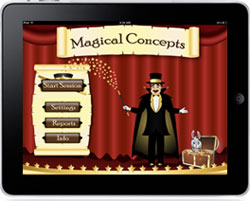Auditory Workout: This app, developed by Beata Klarowska, M.S. CCC-SLP, is one of the best I have seen for receptive language. She has clearly given a lot of thought to all aspects of app usage for professional use.
The app strategically works on prepositions, colors, size, quantity, spatial, and temporal concepts in a following directions format within four sections in ascending order of complexity: Basic Concepts, Quantitative and Spatial, Temporal, and Conditional Directions. One can start a student in the section and level of one’s choice. The instructions for each screen are clearly narrated. Once the narrator finishes the instruction the child taps on one of the pictures. (I appreciated the narrator’s rate of speech and the time given for the child to process the instruction.) Each screen has five pictures that are clear and uncluttered. Now here is an example of a well-thought out app. When the instruction is being given, the pictures choices are framed individually and the screen is slightly opaque. At this point, the child who taps the screen does so in vain. Nothing happens. The child needs to wait until the complete instruction is given. At that point, the frames disappear and the picture choices are seen in their full clarity. There is a Repeat button on the bottom of each screen. The top of each screen clearly indicates the type of direction, the level being worked on, the name of the child and the direction (Example: “Follow directions with concept before in the beginning of the sentence + size + object”). The child can see basketballs accumulate for each correct answer. As the child sees his progress in basketballs, the adult will see the child’s level of accuracy, in percentages. Later, one can review each child’s scores for each level in the database.
The Settings screen allows one to select a number of features such as automatic paging, sound indication for a correct or incorrect choice, and turn on/off the the answer. If one turns off automatic paging a Go button needs to be tapped after the child has tapped on his answer. A third button, Next Page, appears at the bottom of each screen after the child’s response has been determined to be correct or incorrect. This button allows the adult to to proceed to the next page. The app allows for there to be multiple users during a session by changing the User Alternate Count.
The app offers two reward game options: basketball and catch ball. In Settings, one can determine at what point the game reward appears. The app recommends basketball for older children and catch ball for the younger crowd. I tried both. I found the basketball game to be awkward. The area of play is narrow; the net and backboard are bordered by walls to the left and right. One needs to hit the walls on precise points in order for the ball to drop into the net. Otherwise the ball drops frustratingly down to the floor. Catch ball was easier and thus more rewarding. In catch ball, one moves a box around the screen and catches as many balls as possible as they enter the basketball court. The child can view his score on the screen’s backboard for each game.
For those of us who find working on following directions and concept learning a tedious affair, an app, such as this, is what makes the iPad an incredible tool and the task enjoyable.
Ages: 4-8 years (The developer designates the age range for this app to be four to ten.); adults who are aphasic or for those who may be mentally declining.
Ratings: ++++1/2
Developer website: Virtualspeechcenter.com
Cost: $19.99

